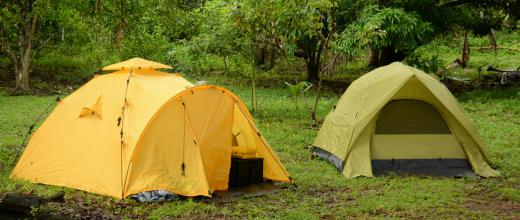At Sports&Hobbies, we're committed to delivering accurate, trustworthy information. Our expert-authored content is rigorously fact-checked and sourced from credible authorities. Discover how we uphold the highest standards in providing you with reliable knowledge.
What is a Tent Stake?
In the past, setting up a tent was often a major headache, but today’s tents nearly assemble themselves. Popular dome tents made of durable rip-stop nylon pop up in minutes with little effort. However, you might find your tent rolling away with the first breeze unless you use a text stake at each stake loop to secure it.
A tent stake is a spike of varying design, driven into the ground at a 45° angle around the perimeter of the tent. The number of tent stakes required depends on the size of the tent, but most tents feature double-stitched nylon stake loops at each corner and at midway points on each side. These loops attach to the heads of the stakes, with the tent stake positioned so the stake loop is pulled taught. This keeps the bottom of the tent flat and prevents damage. It also keeps the tent from shifting position.

There are many designs of tent stakes for use in different terrain. For example, a tent stake designed for hard ground will not secure a tent in sand or snow. Therefore, it might be wise to invest in a few different sets of tent stakes so that you are always prepared to pitch your tent.
Rocky ground: The spike tent stake is made for pitching your tent on rocky ground. These stakes resemble thick, pointed railroad spikes and are sometimes called “rock buster” stakes.

Hard ground: Needle tent stakes, also referred to as Shepherd’s hooks, resemble knitting needles with hooked heads. These tent stakes come in varying lengths and in different types of material, including extremely strong titanium. Needle stakes of inferior quality are sometimes included with a tent purchase. If the metal is too soft, the tent stake will bend when hammered. Because these stakes are lightweight, they are not good for breaking through rock, but their thin profile allows them to be driven more easily into hard soil.
Hard to medium ground: The angle iron tent stake can take a beating, and its larger profile makes it more versatile than other types. It can be hammered into hard ground with a little more muscle than it takes to hammer in needle stakes, but the angle iron tent stake will hold better where the ground is somewhat looser. For an all-around tent stake, the angle iron is probably the best bet, though it won’t suffice in snow or sand. Plastic tent stakes are often shaped like angle iron stakes, but inferior grades of plastic will not hold up to hammering.
Sand, snow or icy ground: Tent stakes for this purpose are generally made of durable lightweight aluminum, shaped like angle iron, but with holes or vents punched into the design. This allows cold ground to form ice through the holes, creating a “grip” on the tent stake. In sandy terrain, the holes create drag for the tent stake. An alternate tent stake design for sandy ground resembles a needle stake with an inverted pyramid plate attached to the top third of the tent stake. In sand, it may be helpful to place a heavy rock over the buried portion of the tent stake.
Tent stakes are modestly priced and available wherever camping gear is sold. Protect your tent with quality tent stakes and you’ll thank yourself for this small investment that pays off in big dividends.
AS FEATURED ON:
AS FEATURED ON:












Discussion Comments
After putting up a new tent with the flexible tent poles, I will never go back to an old tent with the metal poles again! The newer tents are so much easier to figure out and you don't have to worry about all of the poles getting mixed up or lost.
We spend a week every summer camping in the mountains, and the ground is usually pretty hard and rocky. I have found the best stakes to use are either metal or steel tent stakes. You need something that is going to hold up in hard ground like that.
You may wish to check the current research on staking tents. I believe, it is now recommended to drive the stake into the ground vertically.
Post your comments